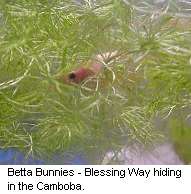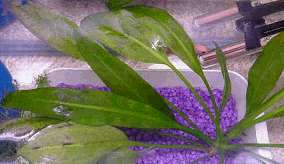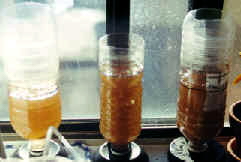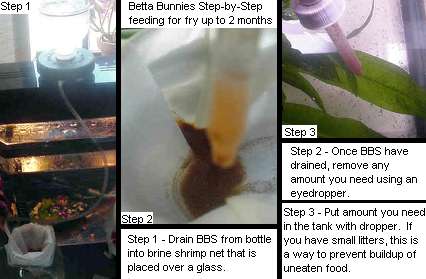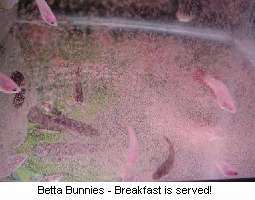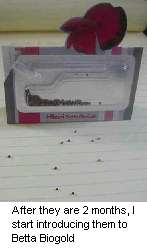How I Breed My Bettas
I generally use a 10 gallon glass aquarium with a close fitting full hood. The reason behind this is because the full hood prevents drafts over the top of the water that can kill a young developing betta. The labyrinth organ in the bettas is what allows them to breathe air from the surface of the water. If there is a draft it can cause this organ not to develop properly. The 10 gallon tanks are also the most cost effective (cheapest). If funds are not available for a close fitting hood, use wax paper taped over the top of the tank as shown below.

I use 2 gallons of tap water treated with 1/4 teaspoon each of NovAqua and AmQuel. I then add an additional 2 gallons of distilled water. There is a 4 x 4 sponge filter in a back corner of the tank. I also use one of those plastic rectangular trays you sometimes get with frozen dinners in the center of the tank. In this tray I place gravel and 2-3 assorted live plants. Some of the plants I use form leaves that float on the surface of the water creating and ideal spot for a bubblenest. One type of plant that works well is a well grown Amazon Sword.


Another kind of plant I use grows well and forms leaves on the surface of the water similar to water lilies. These floating leaves are narrower than the lily and when they bloom they form long, thin spears that surface out of the water with several small white flowers all along the tip of the spear. These plants are found on the shelves as dried bulbs, usually 6-8 bulbs per package. They are known as Aponogeton bulbs and are sometimes available in the Wal-Mart fish section. The plants start to sprout in water after immersed for 2 weeks or so.
In some of my tanks I have floating plants called Camboba. These form excellent hides for harassed females. Some females just like to wiggle their way throught them like if they are scratching their backs.
During the winter months I use a 25 watt submersible heater to regulate the temperature at 80ºF. The heater is placed against the back wall of the tank and attached with suction cups (included in heater package). The sponge filter operates at a constant flow to ensure that the biological filtration works to prevent ammonia buildup which can occur if the flow is too slow. To keep the surface of the water from getting too rough, I make sure the water level is below the tube of the sponge filter.
Once the tank is set up, I wait about 2 to 3 days for it to settle. In the meantime I feed the prospective breeding pair live food to condition them for breeding.
I add the male betta and allow him to adjust and dominate the tank, another day or two. If you look closely, you can see a yellow male under the leaves at the top center. He is building a nest under these leaves.
I place the female next to the breeding tank for about a day. This allows the pair to see each other and gets them stimulated for mating.
After a couple of days, I float the female in a plastic bag in the breeding tank to acclimate her to the temperature of the tank. After about 1/2 an hour, I put her into a lantern glass for a day or overnight.
If she is in the glass overnight, I turn her lose the next morning and spawning usually occurs that afternoon. If she is in the glass for several hours and turned loose before nightfall, they are either spawning that night or early the next morning.
The female is then removed and placed back into her tank once the spawning is done. I add a 1/4 teaspoon of PolyAqua to her tank to prevent any infection from the 'attentions' of the male.
The male guards the nest and places errant eggs into the nest for the next 3 to 5 days. I keep the male there until all fry are free swimming. I have better luck if I let the male figure it out for himself, even if they do lose their first one or two litters. The eggs will usually hatch in 2 days and the fry free swimming by day 5. On day four I mix a batch of brine shrimp eggs and I remove the male on day five.
I feed the fry their first meal of baby brine shrimp (BBS) the very next day. I mix a new batch every time I feed and have three hatcheries on a constant turnover. The fry get fed 2 to 3 times a day and ramshorn snails to eat up the leftovers.
I add prepared aged water every week after the first month until the tank is full. At that time the fry are large enough and usully quick enough to evade the suction of a small air hose. I siphon debris from the bottom of the tank through a brine shrimp net to catch any small fry not quick enough to evade the hose. This siphoned water is usually used to water the plants - they love it.
I do this siphon bit every week, replacing the water removed with clean, aged water. After the fry are about 2 months old, I start jarring the larger fry and introduce them to other live food, such as tubifex worms, black worms and Hikari Betta BioGold pellets.
They thrive on this and will seem to double their size in a week. When they are 3 to 3½ month, I can tell the males from the females, start culling, and are ready for market by the time they are 4 months old.




